#One of my favorite sea mammals
Explore tagged Tumblr posts
Text
Digital - Leopard Seal

8 notes
·
View notes
Text
Round 3 - Mammalia - Carnivora




(Sources - 1, 2, 3, 4)
Our next order of mammals is Carnivora, mammals specialized primarily in eating meat. A diverse order, Carnivora contains the living families Canidae (“dogs”), Ursidae (“bears”), Phocidae (“earless seals”), Otariidae (“eared seals”), Odobenidae (“Walrus”), Mephitidae (“skunks” and “stink badgers”), Ailuridae (“Red Panda”), Procyonidae (“raccoons”, “coatis”, “ringtails”, “kinkajous”, and kin), Mustelidae (“weasels”, “badgers”, “otters”, “Wolverine”, and kin), Nandiniidae (“African Palm Civet”), Viverridae (“civets”, “genets”, “Binturong”, and kin), Herpestidae (“mongooses”), Eupleridae (“Malagasy mongooses”), Hyaenidae (“hyenas”), Prionodontidae (“Asiatic linsangs”), and Felidae (“cats”).
As the sixth largest order of mammals, Carnivora is very diverse and exhibits a wide array of body plans, varying greatly in size and shape. They usually have large, conical, thick, stress-resistant canine teeth. Most species have eyes on the front of their face, pointing forward. They often have a very well-developed sense of smell. Some carnivorans have retractile or semi-retractile claws. Carnivora is separated into two suborders, Caniformia and Feliformia, with Caniforms containing canids and their relatives and Feliforms containing felids and their relatives. (Yes, even in taxonomy, there is a dichotomy between cats and dogs.) Caniforms have longer jaws and more teeth, with less specialized carnassial teeth. They also tend more towards omnivory and opportunistic feeding, while the feliforms, other than the viverrids, are more specialized for eating meat. Some carnivorans have secondarily evolved mainly herbivorous diets. They exist in almost every habitat, from the polar North to hyper-arid deserts to marine seas.
Male carnivorans are usually larger than females. Some species are social while others are solitary. Some species only meet to mate, some form family groups organized around a breeding pair, and some involve a single male or males leading a harem of females and their young. Carnivores usually invest a lot into their young, teaching and raising them to adulthood.
Carnivoramorpha as a whole first appeared in the Paleocene of North America about 60 million years ago, as small marten-like or civet-like predators of insects, lizards, and other small vertebrates. Feliforms and Caniforms split around the Middle Eocene, about 42 million years ago. The precursors to the living feliforms remained forest-dwelling, arboreal or semi-arboreal ambush hunters, while the caniform precursors were more mobile, opportunistic hunters.

Propaganda under the cut:
Canids tend to live as monogamous pairs. Wolves (Canis lupus), Coyotes (Canis latrans), African Wild Dogs (Lycaon pictus), and Dholes (Cuon alpinus) live in groups that include a breeding pair and their offspring. Wolves may even live in extended family groups. Living in family groups allows these animals to work together to take down prey larger than themselves.
The Domestic Dog (Canis familiaris) was the first species to be domesticated by humans, from the Wolf (Canis lupus), more than 30,000 ago when humans were still hunter-gatherers. Domestic Dogs have evolved alongside humans, adapting to better understand and communicate with us, read human body language and expressions, and smell human emotions. Both dogs and humans release oxytocin while spending quality time together, a sign of a strong social bond. Over 340 breeds of Domestic Dog have been selectively bred for tasks such as hunting, herding, pulling loads, detecting a variety of scents, protection, and companionship, with various breeds also filling roles in therapy, aiding disabled people, and assisting police and the military.
According to the Creation Myths of the Serer People, jackals were the first animals on Earth, and the first intelligent beings before humans, and will be the last. In some stories, the jackal is sent to Earth by Roog as a messenger, and in others as a fallen prophet for disobeying the laws of the divine. The movements of the jackal are carefully observed, because the animal is viewed as a seer who came from the transcendence and maintains links with it. Although believed to be rejected by the other animals and deprived of its original intelligence, it is still respected because it dared to resist the supreme being who still keeps it alive.
The Polar Bear (Ursus maritimus) is the largest land carnivore, with adult males weighing 300–800 kg (660–1,760 lb) and being 200–250 cm (6.6–8.2 ft) long. Females are smaller at 180–200 cm (5.9–6.6 ft) with a weight of 150–300 kg (330–660 lb). Adults may stand 130–160 cm (4.3–5.2 ft) tall at the shoulder. The largest Polar Bear on record, reportedly weighing 1,002 kg (2,209 lb), was a male shot at Kotzebue Sound in northwestern Alaska in 1960.
The word “panda” derives from the Nepali word “ponya”, which means “ball of the foot” and “claws”. The Nepali word for the endangered Red Panda (Ailurus fulgens) is "nigalya ponya", which has been translated as "bamboo-footed", due to the animal’s adapted wrist bone which allows it to grip bamboo. When the Red Panda was first described in 1825, it was named an English shortening of this name: “panda.” For more than 40 years the Red Panda was known as simply the panda: the one and only panda. However, when the vulnerable Giant Panda (Ailuropoda melanoleuca) was described in 1869, it was also given the name panda. Historically, there was much debate over the taxonomic positions of these two species, as they were both carnivorans that had adapted to a very specific diet of mostly bamboo. However, we know today that the Giant Panda is indeed a bear and not closely related to the Red Panda, which is the only living member of its own family.
The endangered Giant Otter (Pteronura brasiliensis) is a semi-aquatic predator of north-central South America, and is capable of bringing down animals as tough as a small caiman. Giant Otters live in extended family groups, and are highly social with each other, but extremely territorial of other groups. Battles between groups sometimes break out at the boundaries between territories.
Weasels (genus Mustela) have a behavior called the “weasel war dance”, which consists of a frenzied series of hops sideways and backwards, often accompanied by an arched back and a frizzed-out tail. The weasel war dance happens when the animal is excited or happy, and often occurs after they have caught or killed their prey, or are playing.
Ferrets (Mustela furo) were domesticated from the European Polecat (Mustela putorius) around 2,500 years ago. The Romans used ferrets to hunt rabbits, rodents, and moles, as they are specifically adapted to squeeze into holes after prey. Genghis Khan, ruler of the Mongol Empire, is recorded as using an army of ferrets in a gigantic hunt in 1221 that aimed to purge an entire region of wild animals.
The smallest carnivoran is the Least Weasel (Mustela nivalis). Average body length (not counting the tail) in males is 130 to 260 mm (5 to 10.2 in), while females average 114 to 204 mm (4.5 to 8 in). Males weigh 36 to 250 g (1.3 to 8.8 oz), while females weigh 29 to 117 g (1 to 4.1 oz). Despite their diminutive size, Least Weasels are still effective predators, and can take on prey up to the size of a rabbit.
The North American Black-footed Ferret (Mustela nigripes) declined throughout the 20th century, primarily as a result of declines of its main prey, Prairie Dogs (genus Cynomys). In 1979, it was declared extinct. However, a small wild population was discovered in Meeteetse, Wyoming in 1981! A captive breeding program was launched, using these ferrets, and a reintroduction campaign was put into play. Today, over 200 mature individuals are in the wild across 18 populations, with four self-sustaining populations in South Dakota, Arizona, and Wyoming. In 2008, the Black-footed Ferret’s IUCN status was changed from “extinct in the wild” to “endangered”. In February 2021, the first successful clone of a Black-footed Ferret, a female named Elizabeth Ann, was introduced to the public. She was cloned using frozen cells from Willa, a female Black-footed Ferret who died in the 1980s and had no living descendants. This exciting development opened the doors to a new option for introducing much-needed genetic diversity into the captive breeding population. Elizabeth Ann could not breed herself, due to a condition unrelated to the cloning process, but in 2024, two new Black-Footed Ferret clones, Noreen and Antonia, were also cloned from Willa’s frozen cells. Antonia has since birthed a male and female kit, and Noreen is waiting for a suitable match.
The Honey Badger (Mellivora capensis) is famous for its strength, ferocity, and toughness. It is known for being able to fearlessly fight back when cornered, sometimes even dissuading Lions (Panthera leo) and Spotted Hyenas (Crocuta crocuta) from attacking it. It often raids beehives in search of honey and larvae, and is unbothered by bee stings, which have trouble penetrating its thick skin. They have been observed to kill and eat Black Mambas (Dendroaspis polylepis). They are also highly intelligent, and have been observed manipulating tools and performing complex problem-solving. Despite all this, they are only dangerous to humans if provoked, and most of their reputation comes from their willingness to defend themselves.
There are three species of raccoon, and the small, critically endangered Cozumel Raccoon (Procyon pygmaeus) is the rarest of them. It is native only to Cozumel Island off the coast of the Yucatan Peninsula, Mexico. It is estimated there are only around 192 mature individuals left in the world.
Walruses (Odobenus rosmarus) have powerful, mobile lips that they can use to generate high-powered suction. They do this to feed on one of their favorite prey items: clams. A Walrus can suck the meat out of a clam by sealing its powerful lips to the animal’s shell and withdrawing its piston-like tongue rapidly into its mouth, creating a vacuum. They can also use their mobile lips to whistle in the same way humans do!
The Baikal Seal (Pusa sibirica) is the only species of exclusively freshwater seal. They are native only to Lake Baikal in Siberia, Russia. The most recognizable characteristic of the Baikal Seal is its large, dark eyes. Lake Baikal is the deepest lake in the world, and has varying levels of light intensity. The seal’s large eyes allow it to take in as much light as possible in this environment.
The African Palm Civet (Nandinia binotata) is the most genetically isolated Carnivoran, being the only species within its whole superfamily.
The Jaguar (Panthera onca) employs an unusual killing method: it bites directly through the skull of mammalian prey, between the ears, to deliver a fatal blow to the brain. It does this with a powerful bite force of 1,500 PSI. This bite also allows it to pierce the shells of turtles and the osteoderms of caimans.
When Cecil the male African Lion (Panthera leo leo) was killed in July 2015 by Walter Palmer, an American recreational big-game trophy hunter, there was international uproar and a change in the atmosphere regarding trophy hunting. There was also worry amongst the scientists who had been studying Cecil’s pride that his cubs were now in danger. When one or more new male Lions replace a previous male(s) associated with a pride, they often kill any existing young cubs, to ensure that only their bloodline is produced going forward. However, Cecil had formed a partnership with another male lion named Jericho. When Cecil was killed, Jericho took over the pride but did not kill Cecil’s cubs, and also protected them from any rivals.
The Domestic Cat (Felis catus) was domesticated from the African Wildcat (Felis lybica) about 10,000 years ago. Ancient Egyptians revered the Domestic Cat, and families would take their dead cats to the sacred city of Bubastis, where they were embalmed and buried in sacred repositories. Cats eventually replaced Ferrets as the pest-controlling housepet of choice in Ancient Greece and Rome, as they were considered more pleasant to keep around the house. Like dogs, they have adapted to live alongside us, evolving new vocalizations, body language, and behaviors specifically for communicating with humans, and generally becoming a social species (the African Wildcat is typically solitary and territorial). Today, there are over 41 breeds of Domestic Cat, and they are kept mainly for companionship and pest control. Unfortunately, they have also become one of the most abandoned pets.
The Cheetah (Acinonyx jubatus) is regarded as the fastest-running land animal. It is capable of running at 93 to 104 km/h (58 to 65 mph) in a sprint.
The Asian Palm Civet (Paradoxurus hermaphroditus) is threatened by poaching and the illegal wildlife trade in Indonesia. They are captured for use in the production of kopi luwak. Kopi luwak, also known as civet coffee, is a coffee that consists of partially digested coffee cherries, which have been eaten and defecated by the Asian Palm Civet. The cherries are fermented as they pass through a civet's intestines, and after being defecated with other fecal matter, they are collected. What was once a traditional drink, made from coffee cherries collected from civet feces in the wild, has become increasingly commercialized due to international demand and curiosity. Now, to meet demand, Asian Palm Civets are captured, kept in battery cages, and forcefed nothing but coffee cherries. The civets in kopi luwak farms are kept in abysmal conditions which include isolation, poor diet, small cages, and a high mortality rate. Kopi luwak is one of the most expensive coffees in the world, with retail prices reaching US$100 per kilogram (2.2 lbs) for farmed beans and US$1,300 per kilogram for wild-collected beans.
In some countries, the African Civet (Civettictis civetta) (image 4) is threatened by capture for the perfume industry, as its pheromone civetone is often used as a natural musk. The Calvin Klein-brand male cologne Obsession utilizes synthetic civetone, making the cologne highly attractive to feliforms. Obsession is sometimes used in the field to attract wild cats to camera traps, and is also used in zoos and sanctuaries as scent enrichment.
Mongooses (family Herpestidae) are one of at least four known mammalian taxa with mutations in the nicotinic acetylcholine receptor that protect against snake venom. This makes them fierce and effective predators of venomous snakes.
The Spotted Hyena (Crocuta crocuta) lives in large clans which can consist of up to 80 individuals. These clans are typically led by females, though they can occasionally co-dominate with a male. Clans are run by a matriarch, and her youngest female cub will become the new matriarch when she passes. When a male co-dominates with a female or is otherwise able to lead, this is because the male was born to the matriarch of the clan and has taken the rank directly below his mother.
The Aardwolf (Proteles cristatus) is a small, basal hyena that mainly eats termites. Like other animals adapted for eating termites, it has a long, sticky tongue.
Carnivorans usually occupy a very important part of the ecosystem, and most apex predators are carnivorans. Apex predators can be considered ecosystem engineers, due to the huge impact they have on their environment. One of the most famous examples of this was the reintroduction of Wolves (Canis lupus) in Yellowstone National Park. In 1884, the state of Montana instituted a bounty on Wolves: one dollar per Wolf killed. Wolves were considered a “menace” to Yellowstone’s wildlife, and more concerted efforts mounted to exterminate them. The Elk (Cervus canadensis) population began to explode, and they grazed their way across the landscape, killing young brush and trees. As early as the 1930s, scientists were alarmed by the degradation and were worried about erosion and plants dying off. By the 1970s, there were no resident populations of Wolves in Yellowstone, and Wolves had been almost completely eradicated in the lower 48 states. In 1974, the Wolf was listed in the endangered species act.
Starting in January 1995, Wolves from Canada began to be relocated to Yellowstone National Park. In the years that followed, wolves brought the Elk population down and their presence protected the open valleys from overgrazing, as the fear of predators kept the herds on the move. Willows (genus Salix) began to grow larger, with an increase in size of 1,500% by 2020. With the foliage returning to the park, Beavers (Castor canadensis), Lynxes (Felis lynx canadensis), Wolverines (Gulo gulo) (image 1), and many other formerly reduced species began to rebound. Beaver colonies have grown from 1 in 1995 to 19 by 2015 with four active dams in use. The dams build wetland ecosystems, used by millions of other species. This is an enduring example of a Trophic Cascade: a powerful indirect interaction that can control entire ecosystems, occurring when a trophic level in a food web is removed or added.
Even though domestic carnivorans like the Domestic Dog, Domestic Cat, and to a lesser extent, the Ferret, are some of the most popular pets in the world, most wild carnivorans have been, and still are, unfairly demonized. Many species have been overhunted, resulting in extirpation in some areas. Even early “conservationists” did not understand the value of predators, considering it a boon to the ecosystem to wipe them out entirely. Bounties are still placed on carnivorans today, and many ranchers and farmers push to have them completely wiped out to protect their livestock. If you cross the border of Yellowstone into a nearby town, you must be ready to hear all about how Wolves are evil creatures who kill for pleasure, and are going to kill all the precious Elk. It is a constant uphill battle to reintroduce carnivorans who may have been extirpated from their historical ranges. Yet in some places, humans have learned to coexist with these important parts of the ecosystem. One of the best ways to support carnivorans is through ecotourism. Locals tend to see more value in the predators they have to share space with when visitors are both excited about and bringing in tourism revenue because of these animals.
#animal polls#round 3#mammalia#I didn’t mean to post this early for some reason the schedule turned into a post now button when I went to edit it#but here we are#my buffer has finally caught up to me and here I am writing about carnivorans at 3am when I have to get up in 3 hours and drive for 12#rip me#sorry there’s not more fun animals facts
156 notes
·
View notes
Text
Picrews I like as a regressor ☆´ˎ˗ ︶︶︶
Blatantly based off this post by @thetinyblossom because making picrews is certainly in my top 10 favorite regression activities and I'd like to compile some of my favorite picrews as well :3

🖌️ My room 🖌️


About: A room maker and half body character maker with a cutesy style.
Variety rating: This picrew has two very basic dark skin tones and practically no good curly hairstyles. It's more feminine and androgynous leaning but can be used to make any kind of child, chibi-like character regardless of gender.
🌊 Let's go to the sea 🌊


About: A simple half body maker with sea/pool/swimming themes.
Variety rating: This picrew has four basic skintones, no curly hair options (there's some wavy hairstyles but not quite curly). The cutesy artstyle makes it easier for fem/neu leaning characters.
🍬 Macarons 🍬



About: A very cute and yummy food and character maker with a simple chibi artstyle.
Variety rating: the curly hair options are very underwhelming and the darker skin tones aren't even dark, but the macaron itself is very customizable as it's the focus of this picrew.
🏠 Room picrews: 1st, 2nd 🏠


About: Two room makers for those who would like to envision their ideal regression room!
Variety rating: The first picrew is more focused on brighter/darker colors and has ton of fandom related options for plushies and posters (just look at the picture I made, lol), while the second picrew has a pastel color palette and 2 to 3 options for each furniture space, but it's still very fun and cute nonetheless!
🍹 Cream soda 🍹



About: Here you make and decorate a cream soda drink! With a little critter of your choice on top of it.
Variety rating: I don't think you can get more variety from a cream soda picrew than with this one! It covers a wide range of colors, toppings and effects, and, most surprisingly, critters! Mammals, dinosaurs, insects, ghosts, dragons and other mythical creatures, you can find there!
🧦 Baby Carrot outfit maker 🧦


About: A fullbody outfit maker with a focus on fashion and tons of outfit options.
Variety rating: Very inclusive! Tons of curly hair and dark skin options, a chubby body type, scars, facial and body hair.
🌙 Terrarium maker 🌙


About: A very pretty and detailed terrarium/aquarium picrew where you make a terrarium or an aquarium instead of a character.
Variety rating: For a terrarium picrew, it has a large variety of options from the shape of the bottle to the color of the sky to every little corner, you can even add animals and human characters!
🍼 Cute person maker 🍼


About: This fullbody picrew must be one of the most agere coded picrews I've ever seen: it includes onesies, pajamas, oversized shirts, pacifiers, costumes, diapers and it's overall very adorable :3
Variety rating: Decent range of skintones, a couple of good options for curly hairstyles and one alternative chubby body type, plus all the agere coded options I've mentioned above!
🐾Littlest pet maker🐾



About: LPS maker!
Variety rating: Although you can't make every single LPS in this picrew (obviously) it has tons of options and cute accessories (and several references to LPS popular if you're into it!!!)

#bruh this post has been sitting on my drafts for so long that one of the picrews i originally linked was deleted so rip#agere#sfw agere#agere sfw#agere blog#sfw agere blog#age regression#age regressor#sfw regression#sfw regressor#agere activities#agere textpost#agere picrew#blankiefort ★´ˎ˗#kitty rambles ★´ˎ˗
132 notes
·
View notes
Text
Wet Beast Wednesday: walrus
There are a lot of iconic arctic animals, such as the polar bear and narwhal, but my personal favorite is the walrus. Known for their large tusks, prominent whiskers, and habit for busting myths creepy eyes, walruses are unique amongst the pinnipeds. Most people know of the two main groups of pinnipeds: Phocidae, the earless or true seals and Otariidae, the fur seals and sea lions. Walruses however are in a class of their own, being the only surviving species of their own family: Odobenidae. A weird fact that I learned researching for this is that taxonoimists used to think Odobenids evolved from bears before later reclassifying them alongside the other pinnipeds. Old-timey taxonomy was wild and came up with some absolutely unhinged ideas. Like they used to think that microbats and megabats weren't related, instead classifying megabats as primates.

(image; a walrus sitting on an ice flow. It is a large, brown mammals with short limbs that end in flippers. Its head has a wide, blunt snout and two long tusks emerging from the upper jaw)
There is one species of walrus, Odobenus rosmarus, divided into two subspecies based on location: the Atlantic walrus (O. r. rosmarus) and Pacific walrus (O. r. divergens). The two subspecies are still very similar and genetic testing indicates they diverged between 750,000 and 500,000 years ago. There used to be a third listed subspecies from the Laptev sea, O. r. laptevi, but they have since been reclassified as a population of the Pacific walrus. Walruses are very large, being the third largest pinnipeds after the two elephant seal species. The Pacific subspecies is larger than their Atlantic brethren with most males reaching an average weight between 800 and 1,700 kg (1,800 to 3,700 lbs). A few males have been known to grow considerably larger than average. Male Atlantic walruses average about 900 kg (2,200 lbs). In both subspecies, females are about 2/3 the size of males and have shorter tusks. a large portion of their weight comes from the thick layer of blubber under their skin that helps them stay warm. Both subspecies have an average length between 2.2 and 3.6 meters (7.4 to 11.8 ft). Walruses have hind flippers that can turn forward to act like feet, letting them crawl on all fours like sea lions. Like true seals, they have no external ears. The skin is very thick and mostly bald. They are born with brown skin that becomes lighter as they age. While swimming, the blood vessels in the skin construct to reduce blood flow and limit heat loss, which makes them considerably lighter, almost white. Males have skin nodules called bossed around the neck and shoulders. Their creepy eyes are the result of eye sockets with no roof and powerful extraocular muscles that let the eyes protrude out of the skull and look both forward and sideways. The famous mustaches are composed of 400-700 thick whiskers. The whiskers are attached to muscles and have both nerve ending and blood supply. They are incredibly sensitive sense organs and a walrus can identify objects as small as 2mm with its whiskers. Their lips are muscular and flexible and aid in creating a large variety of noises.
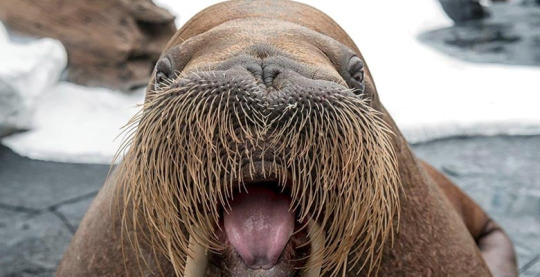
(image: a close-up of a walrus's face, showing its prominent whiskers and small eyes. Its mouth is open, revealing its tongue)
youtube
How come the walrus can whistle but I can't? (video: a walrus in a zoo being instructed by its handler to make multiple vocalizations)
Of course the most famous features of walruses are their tusks. These two large canines can reach a meter in length and are larger in males than females. The tusks have a number of uses in both sexes, though males use them more. In both sexes, they are used to help dig breathing holes in sea ice, hang onto ice and help the walrus climb out of the water. Males also use their tusks in displays of dominance, especially during mating season. Larger tusks are a sign of dominance and typically the walrus with the largest tusks will win standoffs. If a standoff escalates from posturing to a fight, they will use their tusks as weapons. They tend to strike around the neck and shoulders and the skin nodules in those areas help protect males from each other's tusks. It was formerly believed that walruses would use their tusks to dig for prey on the sea floor, but this is no longer believed to be the case.
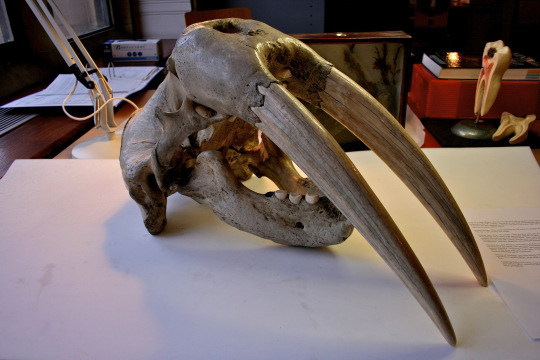
(image: a walrus skull showing the tusks)
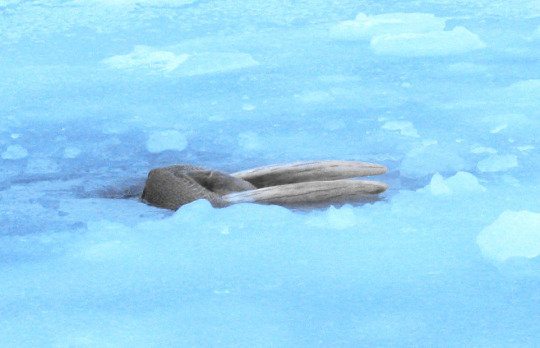
(image: a walrus using its tusks to hang onto the ice and keep its nostrils above the water)
Walruses spend a lot of their time searching for the food they need to support a body that big. They prefer forging along the continental shelf and spend much more time in shallow water than other pinnipeds. While walruses have been tracked diving 500 meters deep, the majority of dives are much more shallow. The vast majority of a walrus's diet consists of seafloor-dwelling invertebrates including tubeworms, soft corals, tunicates, crabs and shrimp, sea cucumbers, and mollusks. While that's a wide palette, their absolute favorite food is clams. To hunt, walruses drag their noses and the forward surface of their tusks through the sediment and use their whiskers to search for food. This stirs up the sediment and releases nutrients back into the water column, a process balled bioturbation. Many foods can be swallowed whole or chewed, but they have a special feeding style for clams and other bivalves. Walruses will hold the bivalve in their mouths and use their flexible lips to form a water-tight seal around it. It then withdraws its tongue into its mouth to create enough suction to suck the bivalve meat right out of the shell. So important is this strategy to feeding that the shape of their mouths is specially adapted to it. Walruses are also known to feed on seals, though how much of that is due to hunting or scavenging is unknown. Additionally, they will scavenge whales, may hunt walrus trapped under sea ice, and have been seen catching and eating birds.
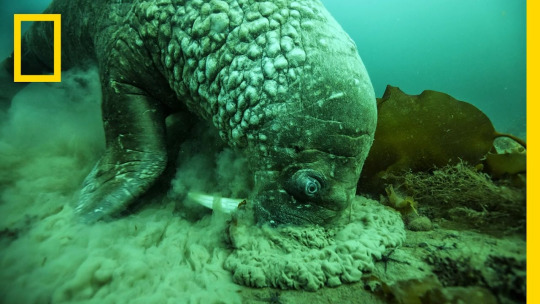
(image: a walrus foraging for food underwater. It has its snout pressed into the sea floor and is kicking up a large amount of sediment. Still from a National Geographic video)
Walruses are social and migratory, traveling south for the winter and north for the summer in aggregations that can be tens of thousands strong. They will haul out onto land or sea ice in huge numbers, blanketing the landscape in blubber and tusks. While these aggregations are preferred, they are not considered a true social species as they do not aid each other when together. Walruses on land or ice are skittish and will spook easily. Being startled can lead to stampedes while the walruses flee back to sea. Sometimes, walruses will be trampled to death during these stampedes. During mating season, the normally cordial walruses become much less friendly to their neighbors. Breeding seasons lasts from January to March. During this time, males will gather in the water around females in heat and compete for the change to get to that nice walrussy (I will not apologize). This is usually done via bellowing and posturing with the tusks, but may escalate to fights. While males become sexually mature around age 7, they often do not become large and strong enough to secure mates until around age 15. Females become sexually mature between 4 and 6 years old. Curiously, females enter heat twice per year, but males are only fertile once per year. Gestation takes up to 16 months and calves are born able to swim and weighing up to 75 kg (165 lbs). Females with calves move away from the large aggregations, possibly to keep their calves from being crushed in stampedes and possibly to make it harder for predators to detect their scent. Nursing lasts for over a year, longer than in many pinnipeds. Walrus milk is fattier than that of land mammals, but less fatty than that of true seals, forcing walrus mother to nurse longer. Even after being weaned, walruses may spend up to 5 years with their mothers. Females only mate at most every two years, which gives the walrus the lowest reproduction rate of all pinnipeds. Walruses can live up to 30 years in the wild and 40 years in captivity. Male walruses have the largest penis bone of any non-cetacean both in absolute size and proportionately.
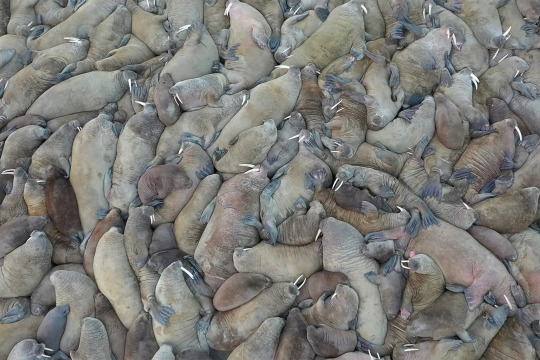
(image an aerial shot of a walrus herd on land. There are many walruses and they are so tightly packed together that no ground is visible)

"Don't talk to me or my son ever again" (image: a mother walrus with its calf. The calf is a smaller version of the mother with no tusks. The calf is sittting by its mother's side. Both are looking at the camers)
Walruses have been hunted by humans living in the arctic circle for millennia. Hunting peaked in 18th and 19th centuries when there was a high commercial demand for meat, blubber, skin, and ivory. This almost led to the extirpation of Atlantic walruses. Since then, hunting has been outlawed except by indigenous peoples, allowing the populations to recover. Now, the major threat to walruses is climate change leading to loss of sea ice needed for hauling out and breeding. The IUCN lists both subspecies as Vulnerable. They were an important source of food and other materials to the peoples of the arctic circle and appear frequently in the mythology of said peoples.

(image: a walrus tusk carved with the images of multiple fish, seals, and polar bears)
#wet beast wednesday#walrus#pinniped#marine biology#zoology#ecology#marine mammals#animal facts#biology#Youtube
525 notes
·
View notes
Text
🐧🐟🦇🐿️🦧🐯🦥🦏
🎷🥁🎻🎸🎸🪈🪘🎹


🌞Introduction post!🌞
☀️☀️☀️☀️☀️☀️☀️


Heya, y'all! How are y'all? •∀• 💚
My name is Emin, but y'all can call me by ma irl name Emina, y'all can even sometimes nickname me as Emi, Mina, Min, Emz, or Emu~ =^_^= 💖💖
Ah'm a teenager =^.^= 💛
Ma birthday is on october 14th ★.★
I'm a muslim ☪️
I'm from Bosnia and Herzegovina 🇧🇦
Even tho I'm a muslim, I'm genderfluid and even transmasc, but even pansexual =^//////^= ❤️
Im an Creative, kind-hearted, sweet, sarcastic, fun-loving, sensitive, sassy, kind, goofy, quirky, gentle, sometimes flirty (in a friendly way), polite and caring lady/guy! And you can vent anything to me.. And all your problems ^///^
I'm a 2D traditional and digital multi-fandom artist 🎨🖼️🖍️🖌️🖊️✏️🖋️
And just know, I'm rully sensitive, even over the slighest things... So be nice here, please... Even to my loved ones in my tumblr family.. •́︿•̀
I support the LGBTQ community 🏳️🌈🏳️⚧️
I might have OCD, maybe even ADD, I can also often be a bit autistic 💚
I'm taken, and my gf is Eliza @elizachangreaves , she's ma sweetheart =^//////^=
I rully love to draw, and ah'm even takin' some practices for animating aswell since ah wanna have ma sunny toons productions company be real ruul soon =^///^= 🎨🖌️🖍️🖼️✏️🖋️🖊️🖌️🖍️✒️
I love all the colors, but I just really love Pink, red, yellow and orange =^_^=
I love roleplays! And I even do roleplays of ma favorite fandoms/hyperfixations =^.^=
I love cartoons and animated shows, they're ma hyperfixations 📺
I love all mammals And sea animals, Ah can't choose one most favorite animal TTwTT
I wear glasses 👓
I'm allergic to peanuts! >_< 🥜
Tumblr was always my home ever since september 24th of 2022, and always will be ♥️
I have a very big and creative imagination, and I practically have lots of odd, yet creative ideas for each one of my shows/series of my company but even my art ideas =^/////^= ❤️🧡💛💖💖
I love crossovers! Even crossover ships, and I even have alot of Ships and otps, and they're all either Canon, my headcanon, or crossover/crackship, I love shippin' characters~ =^.^= ❤️❤️❤️
Ah love lost media, obscure games/cartoons/kids tv shows, and scrapped or lost characters, cause they ruuly give me these kind of good and satisfied nostalgic vibes, and they even give me lots of motivation to draw 'em aswell =^//^= 📼📺🎥

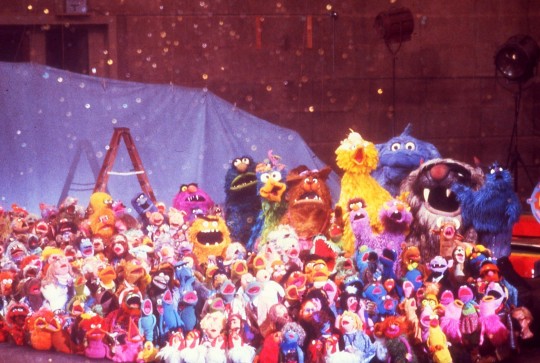
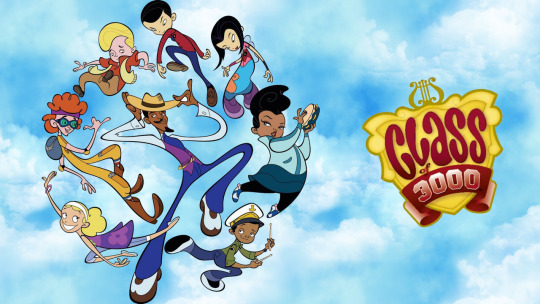

🌞🌞🌞🌞🌞🌞🌞🌞🌞🌞🌞🌞🌞🌞🌞
NOTES:
1. Y'all can make fanart of my 'sunny toons productions' shows and series. Y'all dont have to ask for my permission but just @ me in the post or send me the post on private messages =^.^=
2. Spam likes and reblogs are allowed, go crazy! =^w^=
3. Y'all can swear here, just don't say racial slurs! 0_0
4. If y'all wanna join my team in the 'sunny toons productions' company, just ask me in the private messages, and I'll maybe accept ya. But ya gotta even atleast be one of my loved ones/members of my tumblr family =^/////^=
🌞🌞🌞🌞🌞🌞🌞🌞🌞🌞🌞🌞🌞🌞🌞
RULES:
1. No being rude to me or any of my members in my big tumblr family. I'm very sensitive.
2. Don't be a sexist.
3. Don't be impatient with me. Ah'm a literal teenager, and if ah don't do one of your requests quickly, it's cause ah'm often/sometimes slow with requests and art trades, but not always. And don't throw hissy fits, I ain't yo momma/daddy or your servant/peasant.
4. Don't bash ma opinions.
🌤️🌤️🌤️🌤️🌤️🌤️🌤️🌤️🌤️🌤️🌤️🌤️🌤️🌤️🌤️
My favorite cartoons, shows, games and movies (or fandoms/hyperfixations for short):
The muppets show, class of 3000, jungle bunch: to the rescue!, jungle bunch movies (the 2017 and the 2023 one), hero 108, all hail king julien, sesame Street, Tractor tom, Fosters home for Imaginary friends, Farmkids, Ice age (all movies), fanboy and chum chum, the tales from sanctuary city movies, the legend quest movies, kung fu panda (all movies and shows), courage the cowardly dog, original blues clues, blues clues and you, camp lazlo, madagascar (all movies), animal mechanicals, legend quest, yoohoo and friends, yoohoo to the rescue, the croods, dawn of the croods, pokemon, sonic, sonic boom, jujutsu kaisen, the amazing world of gumball, the amazing digital Circus, ena dream bbq, ena series, lazytown Angela anaconda, magic roundabout,mgummy bear show, Monsters inc, Monsters University, dont hug me im scared, orange Roulette, the adventures of fish n chips, Fifi And the flowertots, drawn together, aqua teen hunger force, 2012 littlest pet shop, dandys world, maya the bee (the anime one and the 2012 one), furiki wheels, blaze and the monster machines, penguins of madagascar, dog man, milky way And the galaxy girls, Teletubbies, nature Cat, roary the racing car, psychonauts, talking Tom And friends, ed edd n' Eddy, arthur totally spies, T.U.F.F. puppy, pig goat banana cricket, cuphead show, Turbo: F.A.S.T, Monster high, Winx Club, adventures of Jimmy neutron, Spongebob squarepants, brave little toaster, little curious, rugrats, total drama, psychonauts, my Life as a teenage robot, Looney tunes, bob's burgers, original Betty boop, hello Kitty Paradise, fairly odd parents, cats dont dance, all grown up, Grim adventures of Billy And Mandy, Barimba, super billy, panty And stocking with garterbelt, nane ve limon, muppets 2015, muppets haunted mansion, jim Henson hour, the Garfield Show (from the 90s And 2000s), strawberry shortcake (the old generations), TMNT 2012, Alvin And the chipmunks (the older ones), skunk fu, top Cat, vila amalka, Mr Hopp's Playhouse, Andy's apple farm, sailor moon, anpanman, PaRappa the rapper anime, bear in the big blue house, Lidsville, the Buzz on maggie, old om nom games, scratchin melodii, galaxy high, rock n rule, bratz, amanda the adventurer, Angelo rules, wizadora, ahh! Real monsters, Club Penguin, webkinz, amanda the adventurer, the boondocks, chalkzone, codename: kids next door, as told by ginger, danny phantom, Sabrina the animated series, braceface, my gym partner's a monkey, subway surfers, trollz, A.N.T farm
My favorite singers/music Artists/groups:
Melanie Martinez, odetari, kesha, MARINA, mitski, 6arelyhuman, asteria, kets4eki, vyzer, proz, ashnikko, brit smith, Britney Spears, Lady Gaga, Sodikken, Beyonce, CMTEN, glitch gum, OutKast, Andre 3000, perfume, DAgames, Jack stauber, 1stress, CG5, Skillet, set it off, skypebf, Ayesha Erotica, Upvampin, daryana, Katy Perry, Charli xcx, lizzo, the cardigans, Billie Eilish, Chappell Roan, Millionaires, Demi Lovato, Scratchy, Drowning Pool, Jake Neutron, Dove Cameron, Gwen Stefani, horrormovies, FabFantasy, hauntingclaire, m1v, sinful, maneskin, ghost and pals, maretu, ado, brooksie, panic! At the disco, Tyler the creator, axie
🌞🌞🌞🌞🌞my art statuses🌞🌞🌞🌞🌞
Requests - always Open, but only for the members of my big tumblr family! Theyre the ones I trust. Even for ma fans.
Art trades - the same like the requests. But sometimes even fans can ask for trades.
Commisions - never, so don't ask
Art contests And competitions - for the members in ma big tumblr family, but even my fans if I have 'em.
Art collabs - for the members of ma big tumblr family, even my fans.
Gifts - for the members of ma big tumblr family, even ma fans. Even new loved ones/mutuals and fans in ma big tumblr family.
Art ideas - always open! But don't ask for some basic-ass requests like just a regular dog, butterfly, cat... Etc. Be a bit more creative, that's what ah love.
Roleplays - always open, especially if they're the ones of ma favorite fandoms/hyperfixations.
🌞🌞🌞🌞🌞🌞🌞🌞🌞🌞🌞🌞🌞🌞🌞
~~~~My socials~~~~
Tumblr: sunnytoonsproductions (you're here, silly! =^_^=)
Twitter: sunnytoons123
YouTube: eminsunnytoons
Discord: emishows123toons_03802 (or just type Emin💛🧡)
Instagram: SunnyT00nsPr0ductions
C.ai: sunnytoonsproduction
FanFiction: Sunnytoonsproductions
Here's even a link to ma FanFiction site account:
Deviantart: Sunnytoonsproduction
☀️☀️☀️☀️☀️☀️☀️☀️☀️☀️☀️☀️☀️☀️☀️
Shows/series of 'Sunny toons productions' Company:
1. The muppets show: life in the boarding home
2. Class of 3000: back to the SING!
3. The new adventures of the jungle bunch
4. Subway surfers: surfers from around the world
5. A pimp named slickback's ruulality show
6. Crossover gathering
7. The moopets show
8. The whatnot show
9. The teppums show
10. The parodies cousin show
11. The sunbles show
12. Class of 4000
16. Tamika-San
☀️☀️☀️☀️☀️☀️☀️☀️☀️☀️☀️☀️☀️☀️☀️
My AUs/possible more series for the 'Sunny Toons Productions':
1. Muppets present
2. Muppets save the world
3. Class of 3000: sugar rush
4. Class of 3000 spies and agents
5. Class of 3000 animals
6. The muppets infection
7. Sunny's musics in education and learning
8. Class of 3000 arabian nights
9. Muppets K-12
13. Class of babies
15. Horrifying muppets world
19. The muppets kingdom
☀️☀️☀️☀️☀️☀️☀️☀️☀️☀️☀️☀️☀️☀️☀️
~~~~~~~~~~~My big tumblr family~~~~~~~~~
💗my long-form bff💗: @kriticalmaniac03
(Nicole is not really now my "tumblr sibling" or mother figure since she's not really comfortable with that, so she has a special spot here in my big tumblr family =^///^=)
🩷My tumblr sisters, brothers, and siblings (or just loved ones)🩵:
@kxllboii @cheezekennith @aquamarine-dream-queen @daydayc224 @oscarandgrinchfan @moshywoosh @ilovescaredysquirrel2 @nuggetaubrey @sharkyy599 @nightkit92 @familyoffood @animatronicdoozer @thelazzyblogzz @sugar-miss1 @shrimpathizer @shypeachrunaway @sayuri-does-skits @peaceforpeople @oxxjustfrankieandmikuloverxxo @ducktopia90264 @artismeyou-12 @blackstar044 @nia1sworld @rumplestiltsbear @s4gefr0g @bluebird-in-a-cagedrawing @blo0st4r @fancytigercupcake @classywinnerpeace @dackychansworldofhoshino @itzbluecl0udd @moonlightrosebud2000 @avaford2009 @devillemon085 @untitled14360 @lotlotdefiesgravitywithtater @kornyart @pennyroyald @foreverevanescent @cherrycolaaa1 @alo380 @fluffyrookie @samantha80ssuperstar @dreamkingsworld @sparklycandyalpaca @bubblesnack14 and the rest of my mutuals and loved ones that belong in my big tumblr family~ =^////^=
💖my cool aunt figure💖: @imjustaspie
❤️My girlfriend❤️: @elizachangreaves
~~~~~~~~~~~~~~~~~~~~~~~~~~~~~~~~~~~~~~~
Anyways, ah hope y'all will like ma blog and what ah post, and ah even hope I'll be able to be y'all's mutual and even for some of y'all to be ma loved one/mutual in ma big tumblr family~ =^////^= ❤️❤️❤️
🎷🥁🎻🎸🎸🪈🪘🎹
🐧🐟🦇🐿️🦧🐸🐸🐅🦥🦏
110 notes
·
View notes
Text
The Oceanic Manta Ray (Mobula birostris). (X)
To my two Tumblr followers give me an animal and I'll design a character
#have my favorite sea creature#proud to be one of your two followers#I'm a zoologist of course I saw this and it took me a while three minutes to pick on animal#but if you were really hoping for a mammal you can do the Ocelot (Leopardus pardalis) instead.
5 notes
·
View notes
Note
﹙ 🎫 🦜 🐬 & 🪼 ﹚ for the summertime blues ask game w/ your smosh dr!
౨ৎ. sooo what are we seeing first at the aquarium???
𝓪𝙣𝔰𝙬e𝙧𝙞n𝙜 𝙩h𝙞𝙨 a𝙨𝙠 𝙛o𝙧 𝙢y



ꜱᴍᴏꜱʜ ʀᴇᴀʟɪᴛʏ
🎫 ⊹ ࣪ ˖ PAPER TICKET : what plans do you have for the warm-weather season? is your favorite artist going on tour? do you have a local carnival or fair that comes around every year? a romantic getaway with your s/o? . . . IN 2024. me and spencer have a trip to greece and italy planned, but that’s technically in may. i will very likely drag anyone i can to the beach numerous times throughout the summer. probably will only go to disneyland a couple times because the park is the worst during the summer. i’ll take people if they want to go though, because i have the annual pass. but i already take people year round. i will be taking myself at the very least for my birthday, because that’s a family tradition (going to disneyland for my birthday). Going to a few vendor/farmer street markets is something I’d love to do. And most especially going to aquariums and zoos. Maybe also road tripping up and visiting my family in the Bay Area (not because there’s aquariums and zoos nearby or on the way).
🦜 ⊹ ࣪ ˖ TOURIST TRAPS : are you the type of person to fall into the tourist traps? for the colorful but tasteless gelato on italian streets? paying for a picture with a beautiful bird on your shoulder? . . . DEFINITELY. sure, i can be considered gullible. but also if i get enjoyment out of it, its worth it. and if it can also help the locals who may struggle due to tourism, then i feel it’s still worth it even if its overpriced. i can afford that stuff so i don’t mind the extra money it might cost. but it can also just provide good memories and sometimes even a good insight into the culture of the place im touring. i don’t travel often, but when i travel to greece and italy in may, i will say i am aware of what i am paying for and don’t overdo it. and i’m not the only one who gets caught in tourist traps.
🐬 ⊹ ࣪ ˖ PLAYFUL DOLPHIN : are you an ocean person or a water park person? would you prefer to dive with the pretty fishes and sea shells? or splash around in tubes and go down the tall water slides? . . . OCEAN. though i will say a healthy (not equal) balance is needed for me. i will always love the ocean more than water parks though. it’s such a beautiful part of earth that holds so much precious life. and it, in itself is so fucking gorgeous. i could watch and listen to waves crashing on the shore for ages. and i love being in the ocean or exploring the tide pools on the shore. the moments i’ve gotten to scuba dive for my previous career have been beautiful and so amazing. but also there’s something very exciting and invigorating about water parks that make it a relatively more exciting day than what would be a more relaxing day in or by the ocean.
🪼 ⊹ ࣪ ˖ COLORFUL JELLYFISH : okay, we're going to the biggest aquarium in the world. where are you dragging me first? to the large sharks? the exotic fish? the fish tank tunnel to watch the fish above us? or are you mad at me because you wanted to go get ice cream instead? . . . THE RAYS. sting rays, eagle rays, or if they have manta rays!! they’re my favorite animals and what made me fall in love with marine biology and got me into my previous career. but also sharks i love sharks so much. they’re such a misunderstood species. i would like to see the big ones, the small ones, the friendly ones you can pet. it’s probably not likely they’ll have a whale shark but if they do, we’re going there!! after that i would try and find the mammals, sea lions, seals, whales (which most GOOD aquariums won’t have, but you said biggest sooo), NO DOLPHINS!! i hate dolphins so much 😭😭 then any of the sea birds they may have, not just penguins!! octopus are a big favorite of mine too! the sea jelly exhibits are always so beautiful. i’d want to see if they have any sea slugs or nudibranchs! they’re so pretty too!! i love to see the touch pools with the sea anemones, sea urchins, sea stars, and sea cucumbers!! if they have a deep sea exhibit that is also always fun to see. then the basic fish, exotic, local, those would probably be last on the list for me. but you ALWAYS have to end it with a trip to the gift shop and then a treat from the local ice cream shops of course!
NOTE : thank you for the ask layla!! the aquarium trip will be bomb as fuck i promiiiseee 🙏 i know my way around TRUST
© rrezshifts last updated. 04/05/2025
#rrez’s asks#rrez adores layla ✴︎ᵎᵎ#rrez’s smosh reality#smosh dr#shiftblr#reality shifting#desired reality#shifting antis dni#shifting blog#shiftblr community#reality shifter#shifting awareness#shifting realities#shifting community#shifting motivation#shifting diary#rrezshifts
20 notes
·
View notes
Note
Hello! I've recently come across your blog and I absolutely love it, I'm eating up your shark mer au (much like everyone else lol) and as a prolific lover of whales I MUST ask, what's this about orcas in one of your recent posts 👀👀 tbh I have a few theories but omg you've got my attention even more if that's possible.
Also, the world building you're doing for this au is 👌 peak I have to say. Delicious. Call me a marine biologist the way I want to study all the boys & our lovely remora reader and learn everything about them and their little ecosystem. The way you write them as being marine mammals is so fun and them being more... Creature-y for lack of a better term is one of my favorite takes on typical mermaids, I love it soo much, I'm totally hooked.
Anyways, thank you for sharing your wonderful brain baby with all of us and I'm looking forward to reading all of your future work!! I hope you have a lovely lovely day/night! 💖💫
Call me a marine biologist the way I want to study all the boys
boss, me too. god i hope no actual marine biologist ever lays eyes on these. the liberties i am libertaking dfkjhgflh
thank you so much!! we who grew up liking mermaids/sea creatures don't get enough adult-type media to age into. i'm happy this uhh intersection of mermaid fiction, horror, and monsterfucking romance is finding like-minded enjoyers even though it began as self-indulgent smut. thank you thank you <3
i am curious about your theories about orcas as a prolific lover of whales! mentioned here too, but orcas are so overpowered that it's hard to find a way to write in an orca mer without kinda... implicitly threatening the 141 with extinction. 〒▽〒
(mer au tag)
#mine#ask#mermay#mermaid reader#mer reader#mer au#x reader#fem reader#cod x reader#tf 141 x reader#merman#poly!141#monster lover#monster fucker#call of duty x reader#terato#monster romance#teratophillia#monster boyfriend#monster x reader
142 notes
·
View notes
Text

Pretty sure I have a good guess as to this week's Bestiary Posting animal, so I'm just gonna go totally off the rails for this one.
My thought process was as follows: Three rows of teeth means it must be a shark. And it would be fun to draw a fish, since I haven't done one for this challenge yet. But oh no, it has 'powerful feet'. Fish don't have feet. You know what does have powerful feet though? Mollusks. Mollusks have feet. It's described as having eyes though. What mollusks have eyes? That's right. Cephalopods!
Hence, the Mlekragg is a cephalopod.
Yes, it is a stretch, but sometimes with this challenge I like to imagine I'm an alien illustrator with no concept of what animals humans would regularly encounter. While most humans would probably assume this is a terrestrial mammal, there's no reason an alien would. In fact, considering how many more invertebrates there are then vertebrates, it makes sense for an outside observer to assume any animals described by humans is an inveterate, unless it says otherwise. It's all very sound alien logic, and not just me making wild leaps because I want my imaginary bestiary to have some more variety beyond my favorite birds and mammals. I'm really trying to use this challenge to be more imaginative and crazy with creature designs, and think outside the box when I can.
Anywho, the cuttlefish and nautilus were my main points of reference, though I did look at some reconstructions of prehistoric cephalopods for inspiration. Then I simply took all the elements of the Mlekragg and slapped it onto that body form. The triple row of teeth can't be seen in my drawing, but it is located where a cephalopod's beak would typically be. The 'face of a man' is actually a pattern on it's hood it uses to fool predators. Behind the hood flares out a 'lion's mane', which it uses for display and also to disorient it's prey when it snatches it up. It has a pointed "tail" with a stinger. It doesn't look much like a scorpion's tail - took a bit of artistic liberty and decided it just stings like a scorpion's tail, rather then looks like it. I've decided to interpret 'powerful feet' and 'good jumper' as two different traits. So it's 'powerful feet' are it's tentacles, but it uses it's stinger to leap. Why does a sea creature need to leap? Well, I imagine they live near coasts and occasionally get stranded in tide pools or on land and use their stingers to propel themselves back into the water. It kind of works like a springtail's little 'tail'. Much like the description says, no obstacle can keep the Mlekragg in!
On the bottom right I've drawn a picture of one using it's stinger to leap, and on the left I've drawn a cartoon version of it that accentuates the lion shape/human face idea. With it's tentacles and mane laid back and it's fins hanging down it does look like a little leaping lion. I also gave it a little grin in keeping with the cartoon tradition of putting cephalopod mouths on the mantle, which we know is incorrect. It does make him look like a very personable little gentleman though.
I feel if I were a bit more confident in drawing cephalpods and knew more about mollusk anatomy I could've maybe taken this in an even wilder direction. Maybe I'll revisit it in the future.
95 notes
·
View notes
Text
This is the longer post detailing how I view my hearttypes, and how understanding otherhearted's origins helped me!
Thinking about hearttypes like a daemon-daemian relationship, and what leads me to these specific animals over others, was the main thing in assisting me to draw my lines between kintype and hearttype, and the differences between them.
Wasps: I relate very much to their constant misunderstood demonization, wasps tend to inspire either fear or hatred in seemingly everyone, and for really no good reason. And, just like wasps, I feel I am much more than the assumptions people tend to push on me. Wasps are a giant and varied type of animal, they're not all just yellowjackets, plenty of them can't even sting humans! And many of them do legitimate good for their local environments! They're also quite fascinating; the emerald cockroach wasp is one of my favorites for a reason, although gall wasps I also love because of the diverse mini ecosystem they can produce.
So, like a wasp, I feel people can be very quick to judge my character and intentions, but in reality I am simply trying to just exist just like every other animal.
Reindeer, horses: I connect with these two animals for roughly the same reasons, it's just the sources that are different. Reindeer remind me of my home in Adytum, whilst horses remind me of ancestry (and home) in this life. They're both animals I tend to associate with freedom, but also just a general sense of "home".
Humpback whales: whales, in general, I think are animals that are most likely to inspire the feeling of "awe" in humans. They're incredibly smart! Mammals that live in the ocean! They can be both absolute giants and so tiny! I love sea animals just like I love all animals, but something about whales, specifically humpback whales, makes me drawn towards them. Unfortunately, it's a bit hard to pin down why...
Is it their size? They are one of the largest known animals to have ever existed on earth, after all. Is it kindness towards other animals, even humans who have done detrimental damage to them in the past? Is it just their general intelligence, that makes me feel seen as another intelligent animal? I think I just love everything about them; I am not one of them, but I think they're one of the few animals that aren't one of my kintypes, that I still wouldn't mind if I were to be transformed into one.
Great white sharks: I have attached to great whites for very, very similar reasons that did to wasps (I was attached to them before I was to wasps, actually). They're misunderstood, mainly because of a book that the author later regretted, despite how much good they do to their local ecosystems more often than not. Also just like wasps, they're a lot more diverse than people like to think! (Lemon sharks are so cute!!) But I specifically relate to great whites specifically like how I relate to wasps.
#otherhearted#hearttype#Wasphearted#Reindeerhearted#Horsehearted#Whalehearted#Sharkhearted#alterhuman#the tongue of the serpent speaks#daemonism
13 notes
·
View notes
Text
My tumblr following probably doesn't know this about me, but apart from audios my other hobby is finding and swimming with wild marine mammals. I have a particular affinity for sea lions and dolphins, both of which are gregarious animals with the ability to remember and even form bonds with humans. Here's one of my favorite photo sets I've ever taken.
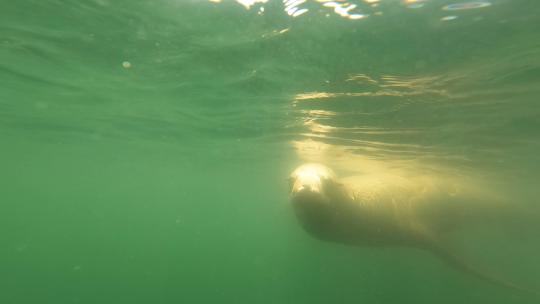
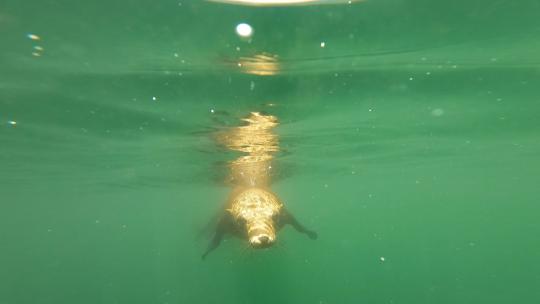
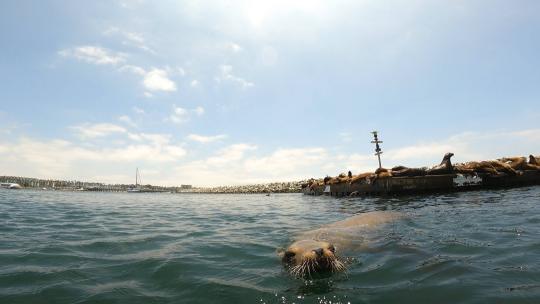
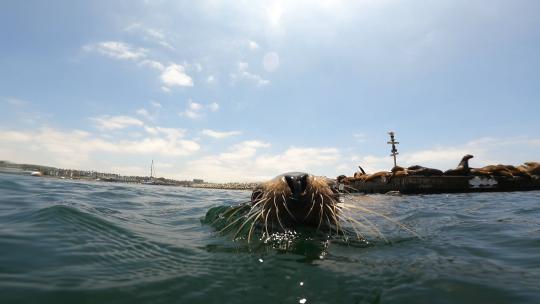


Her name is Sola Rey! She's shy when it's dark out but loves socializing when the sun is bright. She likes coming up to me and giving me forehead "kisses". I had a head mounted GoPro on this time and the pictures were perfect. One of the ways sea lions communicate under water is by nuzzling their whiskers. They do this to communicate to other sea lions that nearby sea lions are not a threat to them. Does that mean she thinks I'm some kind of sea lion too? A mystery. Anyway I love her.
#sea lions#my other hobby#underwater photography#cute animals#kisses#wildlife photography#I'm just a seal boy living in the real world
128 notes
·
View notes
Text
Round 3 - Mammalia - Sirenia

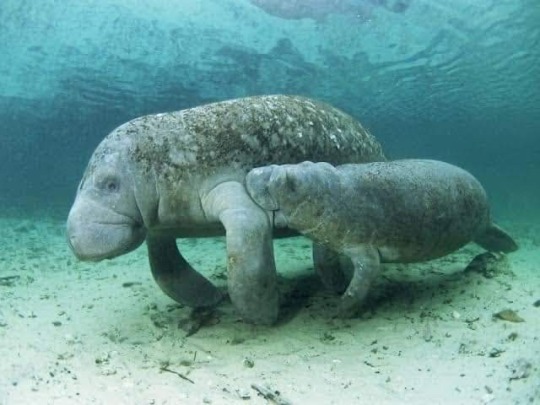
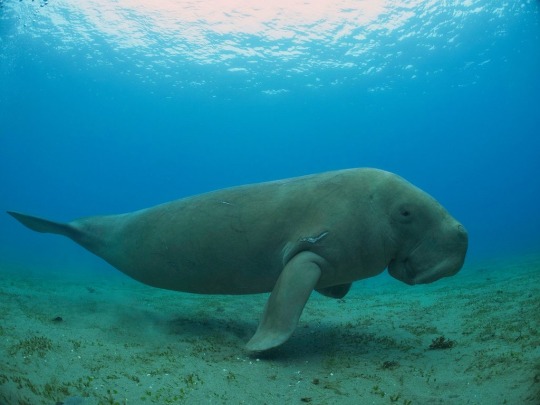
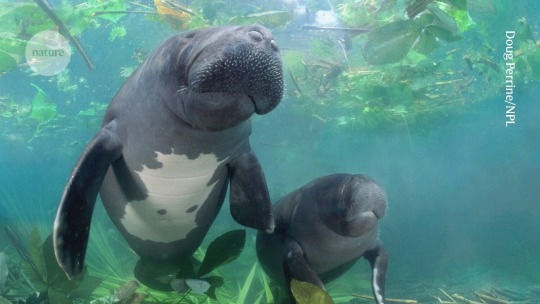
(Sources - 1, 2, 3, 4)
Our last order of afrotherian mammals is Sirenia, commonly referred to as “sea cows.” Sirenia comprises the families Dugongidae (“Dugong”) and Trichechidae (“manatees.”)
As the closest living relatives of elephants, Sirenians are large animals, growing between 2.5 and 4 metres (8.2 and 13.1 feet) long and weighing up to 1,500 kilograms (3,300 pounds). They are aquatic, with long fusiform bodies to reduce drag through the water and heavy bones that act as ballast to counteract the buoyancy of their blubber. Their forelimbs are paddle-like flippers which aid in turning and slowing. West Indian and African Manatees retain nails on their flippers while Amazonian Manatees and Dugongs lack them. Like those of cetaceans, their hind limbs are internal and vestigial. The Dugong’s tail fluke is notched and similar to those of dolphins, whereas the tail fluke of manatees are paddle-shaped. Their blubber layer is thin and sensitive to temperature fluctuations, which cause migrations when water temperatures dip too low. Sirenians are slow-moving, typically coasting at 8 kilometres per hour (5 mph), but they can reach 24 kilometres per hour (15 mph) in short bursts. They use their strong, prehensile lips to graze on seagrasses, consuming 10–15% of their body weight per day. They are mainly herbivorous, but have been known to also eat animals such as jellyfish, polychaete worms, bivalves, and even (dead) fish. Sirenians have poor eyesight but a good sense of smell, as well as highly sensitive whiskers, or vibrissae, which are not only used to sense things, but can be used to grasp and manipulate food. They typically inhabit warm, shallow, coastal waters, or rivers.
Despite being mostly solitary, sirenians congregate in small groups while females are in estrus. These groups usually include one female with multiple males, who fight for the right to mate with her, lunging at each other and sometimes leaving scars with their short tusks. Males leave after mating, taking no part in child-rearing. Sirenian gestation is 12 to 15 months long, and they usually give birth to just one calf. Sirenians invest considerable parental care into their young, lactating for 1 to 2 years and taking care of their calves for up to 7 years before having another, though they can reproduce once every 2-3 years. Sirenians reach sexual maturity between the ages of 3 and 18, depending on species. Females give birth only a few times during their lives.
Sirenians have been around since the Early Eocene, some 55.8 million years ago

Propaganda under the cut:
All three living manatee species as well as the dugong are listed as Vulnerable on the IUCN Red List of Threatened Species. They are vulnerable to extinction from habitat loss and other impacts related to human population growth and coastal development, such as boat strikes, net entanglement, plastic and debris in the water, and pollution run-off causing algal blooms. Climate change is also predicted to make winter months even colder, leading to increased instances of cold stress in manatees, and impacts on their seagrass diet. In some countries, sirenians are still poached for meat, and their calves are sometimes sold as pets on the black market.
The extinct Steller's Sea Cow (Hydrodamalis gigas) was the largest sirenian to have ever lived, reaching lengths of 10 metres (33 feet) and weights of 5 to 10 tonnes (5.5 to 11.0 short tons). This dugongid was described in 1741, and within 27 years of its discovery by Europeans, the slow-moving and easily-caught mammal was hunted to extinction for its meat, fat, and hide.
Dugongs (Dugong dugon) (image 3) are social, though they do not often gather together due to the inability of seagrass beds to support large populations. They are known to communicate with each other through chirps, whistles, barks, and other sounds that echo underwater. Different sounds have been observed with different amplitudes and frequencies, implying different purposes.
The oldest recorded Dugong lived to be 73.
A common belief found in the Philippines, and some parts of Malaysia, Indonesia, and Thailand, is that Dugongs were originally human or part-human (usually women), and that they cry when they are butchered or beached. Because of this, it is considered bad luck if a dugong is killed or accidentally dies in nets or fish corrals. Dugongs are predominantly not traditionally hunted for food in these regions and they remained plentiful until around the 1970s.
Sirenians are often cited as one of the animals that could have inspired the mermaids of legend. While they likely didn’t inspire the mythology itself (there are plenty of half-woman-half-something-else monsters in folklore; medieval sailors and artists didn’t need to see a vaguely-human-shaped swimming animal to come up with a fish-woman), some sailors may have confused manatees and dugongs for the mythological mermaids. One such sailor was Christopher Columbus, who unknowingly penned the first record of a manatee in North America when he recorded a sighting of “3 mermaids,” stating that mermaids were not as beautiful as they had been painted despite having somewhat human faces. In languages like Ilocano, Mapun, Yakan, Tausug, and Kadazan Dusun of the Philippines and Sabah, the name for Dugongs is a synonym for "mermaid". In Malay, they are sometimes referred to as perempoen laut ("woman of the sea") or putri duyong ("dugong princess").
Manatee vibrissae (whiskers) are so sensitive that they are able to perform active touch discrimination of textures. Manatees also use their vibrissae to navigate the turbid waterways of their environment. Research has indicated that they are able to use these vibrissae to detect hydrodynamic stimuli in the same way that fish use their lateral line system.
The Amazonian Manatee (Trichechus inunguis) (image 4) is the only sirenian that lives exclusively in a freshwater habitat. Amazonian Manatees make seasonal movements synchronized with the flood regime of the Amazon Basin. They are found in flooded forests and meadows during the flood season, grazing on plants that would otherwise be unavailable to them, after which they move to deeper waters.
The West Indian Manatee (Trichechus manatus) (image 1) was listed as endangered in the 1970s, when there were only several hundred left. In the decades since, significant conservation efforts have been made to protect the species, particularly from collisions with boats. In 2017, the United States changed the species to "vulnerable", thanks to a significant increase in population.
Over 20% of West Indian Manatee mortalities per year are a result of watercraft collisions. 96% of adult Florida Manatee (Trichechus manatus latirostris) carcasses have scars from a boat collision with some individuals showing signs of 10 or more boat strikes. Manatees respond to approaching vessels by orienting towards deeper waters and increasing their speed, but they are still frequently struck as they don't have the ability to swim very fast and, in shallow habitat, they often don't have anywhere to go to get out of the way. Over half of all watercraft deaths are caused by the impact trauma from the hull of a fast-speeding boat, whereas the remaining percentage is caused by the boat propeller. Watercraft can frequently avoid hitting manatees simply by reducing speed, allowing time for the manatee to escape out of range. Despite improvements in modeling and changes to local regulations, manatee mortalities from watercraft collisions continue to rise, with an all-time high of 137 recorded deaths in 2019.
Harmful algae blooms are an additional threat to manatees. “Red tide” is a common name for harmful algal blooms, deriving their distinctive color from pigmentation molecules in the algae, though harmful algal blooms can also be blue, green, or brown. The blooms produce brevetoxins which are potentially fatal to marine life. Most manatee deaths from red tide occur when manatees inhale the toxins, or ingest the toxins when consuming seagrass, their primary food source. They may also die of starvation when cloudy water leads to their primary source of food being unable to photosynthesize. Algal blooms are a result of an excess of nutrients being dumped or washed into the water, usually from agriculture run-off, sewage, and run-off from fertilized lawns and golf courses.
The African Manatee (Trichechus senegalensis) (image 2) is the only sirenian not known to vocalize.
African Manatees are the most omnivorous of all living sirenians, with around 50% of their lifetime diet being non-plant material. They will occasionally steal clams and fish from nets.
Among the Serer People, the African Manatee is viewed in the Creation Myth as guardian of the secrets of the future.
Some extinct sirenians, such as Pezosiren portelli and Prorastomus sirenoides, retained all four of their limbs, and lived semi-aquatic lifestyles akin to hippopotamuses.
100 notes
·
View notes
Text
One of my favorite crack theories is that the Loch Ness monster is a dinosaur ghost, and that's why no hard evidence can be found of it's physical presence within the lake and cameras tend to "conveniently" go staticky/blurry or malfunction altogether when it appears.
We could apply this to most cryptids if we were crazy enough, really.
Sasquatches are the ghosts of early humans that lived before we had lost our fur.
All lake monsters and sea serpents are the ghosts of long-extinct aquatic animals such as plesiosaurs and dorudons.
The mokele-mbembe is a ghost sauropod, and the legend about it cursing those who eat its flesh is true because it's a vengeful type of ghost, perhaps angry that it was eaten by carnivores in life, or that mammals inherited an earth it feels robbed of.
All cryptids that are mundane animals but of extraordinary size are the ghosts of ice age megafauna.
idk what Chupacabras could be but they're probably ghosts idk.
You get it. We can stretch this as far as we want, and get as ridiculous as we want with it. It's prime pseudoscience; easy to rationalize evidence for, impossible to disprove, and as annoying a theory as you want it to be.
#cryptid#cryptids#ghost#ghosts#occultism#occult#monster#monsters#loch ness monster#loch ness#bigfoot#sasquatch#sasquatches
27 notes
·
View notes
Text
I made Ruby’s roommate and future wife!

This is Michelle “Shelly” Carpenter! She’s a second year Heartslabyul student and Ruby’s roommate.
Shelly is outwardly very cheerful and positive and talkative towards other people. She’s especially chatty when someone mentions theatre, as Shelly is very passionate about theatre in both the context of the actual shows and the sets. She loves design work and constructing beautiful sets that everyone can get immersed in, helping with the story by giving it a proper setting. This trait seems to be hereditary as everyone who was born with the last name “Carpenter” in her family was born with a love for theatre, set designing, and woodworking.
But Shelly is a “my way or the highway” kind of person when it comes to her work, often getting into arguments with other strong-willed people she’s working with. This leads to a lot of arguments with Vil since Shelly makes a lot of props and set pieces for the Film Research Club’s short films and both she and Vil have strong opinions on how they should look. Every argument usually has to be mediated by Rook and Velvette, who get the two strong-willed artists to compromise and thus resulting in beautiful sets and props. Either way, Shelly is as stubborn as a bull when it comes to her craft. She’s an artist, a damn good one at that, and she fucking knows it.
Shelly is also inhumanly fast. I’m being serious when I say she could be a close second to Malleus in terms of speed. When asked about her amazing speed, she tells the story of her great-great-great-great-great-great-great-great-great-not-so-great-grandfather who was just a normal carpenter that had too much to do and not enough time to do it. Tired of always being swamped with work and wanting to get things done on time, he went to a rather wealthy and powerful walrus that was gifted in magic and requested the gift of speed and efficiency be cast upon him and any descendants he may have in the future. The walrus agreed to fulfill this request, only if the man agreed to be his companion and serve him for the rest of his life once his work was completed. Though hesitant, the carpenter agreed to the walrus’s terms and finished his mountains of work in three days and two nights before becoming the walrus’s companion for the rest of his days, becoming the victim of an abusive, lazy, overlord-like figure for years. Eventually the walrus used and abused the kind carpenter one too many times, and after the walrus ate all of the oysters that the carpenter had caught, prepared, and made a loaf of break and a sauce fit for kings as a side all by himself, the carpenter turned red with rage and chased down the walrus with a hammer, catching up to the gluttonous creature with ease thanks to his speed and ending the greedy mammal’s life with his trusty hammer and ending his servitude. This story is why no one in her family trusts walruses all too much because, although a walrus gave them their inhuman speed, that walrus also tortured and abused his power over their ancestor until he’d finally snapped and resorted to murder to end his suffering.
Everyone always looks at Shelly like she’s insane and just a bit terrifying whenever they hear that story, but Shelly just smiles and laughs lightly before she gets back to doing her work with such speed and accuracy that should be impossible for a human girl.
Shelly also loves cooking, especially when she’s handling seafood since her favorite foods are from the sea, particularly oysters. She and Trey usually provide the food for Unbirthday parties and any other Heartslabyul Dorm events, with Trey handling desserts and Shelly handling savory sides that pair well with the sweets Trey makes. Once, while going to get supplies at Sam’s, she spotted the octotrio and almost stopped dead since all she could think was “fish” and “ingredients” when she saw them and she didn’t know why. Her gaze reminded Jade of the first time Floyd looked at Azul and neither of them like that, so Floyd yoinked Jade and all three of them left before Shelly got any ideas. But, long story short, Shelly’s love of seafood makes her drawn to the octotrio for some reason she can’t pinpoint and it makes Azul and Floyd uncomfortable while Jade is very entertained by their panic around her while also keeping distance from the ginger.
Riddle and Ruby are actually very grateful that Shelly scares of Floyd since he likes to pester both of them (Rayne is off-limits because she’s Jade’s pearl, not his) but he zips away when he sees Shelly, who looks at him like he’s prey and not a scary moray! That’s probably because Shelly LOVES eel dishes almost as much as oysters, but she doesn’t know that since she didn’t know the tweels and Azul were merpeople until she heard about it through the grapevine.
And though Shelly is forgiving of mistakes, she doesn’t take well to being stiffed or ripped off, her face going red with rage when she finds out the truth and immediately seeking revenge. Shelly gained a reputation for being the “Vengeful Carpenter” when someone didn’t return their end of the deal when working on a project together, which was really her doing the whole thing and the other one taking all of the credit, thus ending in her scaring the guy half to death and publicly humiliating him as revenge during her first year. After this incident, no one, not even Azul, has stiffed Shelly and she’s since gained a habit of only accepting up-front payment before accepting a job from anyone.
Despite her business sense and seeing through lying douchebags, Shelly is a bit of an airhead at times and has slightly below average grades in subjects like History of Magic and Mathematics, always maintaining a C-minus or 70%-72% average in terms of grades. She will also voice her thoughts with little to no thought before realizing what just came out of her mouth in horror since it’s usually a slightly insensitive thought that she unintentionally spits out and she always apologizes for her inability to think before she speaks sometimes. Though she’s a bit dim witted at times, students and professors see that Shelly is ernest and is just trying her best.
She also has a Cockney accent that gets really thick when she’s really angry or really excited. And even when she’s chilled out and calm, talking in her normal voice, she has to slowly speak for some people who aren’t from the area of the Queendom of Roses where she grew up. And though it surprises most people, Deuce is the one who understands her best since Clocktown is very close to Dawndusk Port, the beachside town where Shelly grew up, and they have similar accents and dialects, though Dawndusk Port has heavier accents and slightly harder to understand dialect than Clocktown. Morel also understands Shelly quite well thanks to growing up hearing her father’s slightly Germanic Scottish accent and having a slight Scottish lit to the way she speaks and pronounced specific words.
But when I say people were shocked that Deuce and Shelly could perfectly understand each other, I mean people were fucking astonished. Shelly was helping Ace and Deuce with work and while Ace had no idea what break had to do with Potionology, Deuce said he “was indeed usin’ his loaf” while working after Shelly told him to “use ‘is damn loaf” for some reason. Their speaking also makes Deice forget he’s not at home and Ace always looks at him weird when he says “I’m goin’ down the store! ya want somethin’?” instead of talking normal. (Ace has a very light, somewhat “standard” British accent so he doesn’t get the slang or dialect a lot of his classmates use)
Overall, Shelly is a positive and hard-working girl who is ernest and trying her best, despite her revenge streak. Just don’t stiff her and you’ll be fine!
#let’s go lesbians let’s go!!!#twst#twst oc#twisted wonderland#disney twst#disney twisted wonderland#michelle carpenter#michelle ‘shelly’ carpenter#shelly carpenter
7 notes
·
View notes
Note
What’s Megumi’s favorite human (or not human) food in THR? Also, what does a mermaids life-cycle look like? Is it live birth or do they grow from eggs? Do they start out like mini mermaids or are they blind and at a disadvantage? How long do mermaids live? How long is their pregnancy periods? Are all life-cycles the same or do they differ between species/type of mermaid? Can two different mermaids have viable offspring? (Like a deep sea mermaid and a non-deep sea mermaid)
Sorry for the wall of text— I have THR brainrot like a mf right now
I had to pull out my computer for this one since it's gonna be LOOOONG !!!!! I love this so much tho lmfaoo !!
Megumi's favorite food
he likes savory foods, so a lot of the diner and lunchy stuff Yuuji makes
He really likes bird eggs since they're something they've never had before
And Megumi likes crustaceans like crab and lobster
Mermaid Life cycle
the life cycle is fairly similar to humans, the younger a mermaid is the more dependent they are on the adults around them. As they age they get more curious
when they reach their mid to late teens, then they start to explore the different jobs/roles of their pod to see which one is best suited for them
late teens and early to late twenties is when courting and relationships develop, marriage or serious relationships form in later twenties or early thirties
Nearing and post menopausal aged mermaids (both male and female) are elders, they guide and protect all pod members younger than them (adult, teen, child). They are also commonly the religious leaders
then death lol
Eggs or Live birth
Mermaids have live birth !! They're mammals so their eggs hatch internally lol
Baby Mermaids
Baby mermaids are born more developed than human babies (since they're incubated longer)
While their eyes and ears are open, their brain doesn't deem those senses important enough to actually register until they're a little bit older (tho this is only for a short while)
They're able to swim around and feel around slightly, but they mainly cling to their parents when they're infants
They also need to spend a lot of time close to the surface since their lungs aren't developed enough to hold their breath for long periods of time
so yeah, they're pretty disadvantaged. They're pretty much the equivalent to 3 month olds when they're born
How long are mermaid lives
around 70-80 years, so pretty much as long as humans do lol
How long are pregnancies
Mermaid pregnancies are around 12 months
mermaids have more room to hold the babies lol (in humans the womb can only really grow up and out, since growing down would mean growing outside the body. But in mermaids the womb can grow up, out, and down, since growing down means growing into the muscle of the tail, so inside the body)
Mermaids also have a bisected pelvic bone, so during birth the bone just moves apart to accommodate the size of the infant's head
Are life cycles the same for different types of mermaids + Can different mermaids have viable children
I'm combining these two since they pretty much have the same answer.
The different types of mermaids (ex: deep sea, surface, twilight, etc) are different mermaid races. They're all the same species, just different genetics due to different environments
so all the life cycles are the same (though there are different culture and environmental factors)
and they can reproduce with one another, the offspring would just be considered mixed race :3
THIS WAS SOO MUCH FUN, THANK YOU SO MUCH FOR ASKING ME SO MANY QUESTIONS
A lot of these (like the pregnancy questions) were things I've had set in stone for a while now, and I'm really happy I got to share them finally !!!
And I'm sorry I never actually mentioned that I was talking about different mermaid races, my dad was actually the one who put two and two together lmao
19 notes
·
View notes
Note
What are your favourite dragon quest monsters across the entire series?
The first Dragon Quest Monsters game I've ever gotten to play wound up being the first one to leave out exactly the top three I looked forward to getting:

GIANTSLUG/MAULUSC: I'm pickier about slug and snail creatures than you maybe expect but I love the vapid drippy zombie face of the DQ slug. It perfectly captures the appeal of a slug as a monster, a mindless gooey thing that will just eat you without a care. And its classic color scheme is that of a Banana Slug!!

BELZEBUB: I am also picky about fly creatures; usually I want them to have the proboscis present in some way, and the correct number of wings (two). There's something I still love about the toothy mouth of Belzebub however, maybe the way it curls up between the eyes? It just does a good job capturing the feel of a fly's personality I guess.

DARKEYE/EYELASHER: eye creatures can also very easily feel a bit boring to me because I've just seen so, so many of them, but DQ's basic killer eyeball appeals to me a lot with its irregular fungus-like collection of tentacles. The little root branches on "top" are especially cool to me, and sometimes they're the bottom, because they represent where the eyeball attaches to either floors or ceilings! In a few games, they're even encountered as parasites inside bigger monsters!
I used to admire the guidebook to the first two DQ Monsters games as a kid but never had the games themselves, and never got around to any other DQ titles. I just spent my whole life waiting for just the right one where I'd finally get to assemble my three favorites, then finally this new one comes out and has to be the first time these three took a vacation :( But, Dark Prince was at least nice enough to include exactly my next three favorites in the franchise. I went over them already in my DQM Dark Prince post but some people will see this post first so I will have to reintroduce them:

DROHL: droopy flappy membranous mollusk guys, honestly horrible looking in a great way. In 3d games it turns out their helmetlike head spirals in the back like a snail shell! Apparently they're meant to be troll-like beings.

LUNATICK: just a blue fleshy sac thing with gooey antennae, a bunch of tentacles (most of them segmented like worms!) and a little eyeball, perfect, no criticisms, also reminds me of what Berserk considers an "Incubus:"
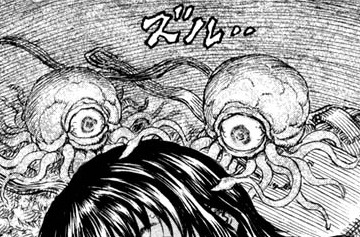
(Don't worry, Berserk Incubus aren't sex monsters but monsters that give you nightmares and feed on the fear)
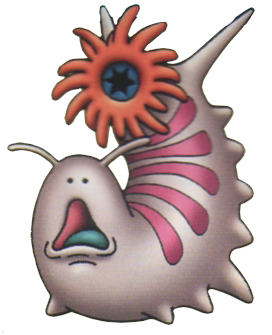
TAILEATER/MAD MOLLUSK: I love how pathetic their front face looks, and the whole shape is so pleasantly reminiscent of an abyssal sea cucumber of some kind.

SKULLROO/GUAARDVARK: I didn't even realize this was one of my top favorites until getting it in Dark Prince. It's an unpleasant wrinkly fat aardvark kangaroo thing that just always carries a human skull around. Its profile says they collect them and the one they carry is their favorite! A lot of slightly lower favorites were also left out however, none of these are in Dark Prince but are very high up there to me:

PYURO: what is this thing? I don't know! Different games have categorized it as an insect or a plant. It's a furball with five eyes encircling a butterfly proboscis, two little legs and a big huge ring of flower petals behind it. Very xenobiology.

TONGUELLA: it's kinda like a dumpy, hairless sloth with an aardvark tail with a mushed-in dog face and a giant gross tongue. I guess I just like foul moist beasts. I wish this was a real mammal we had in the world, I bet it'd smell terrible. Feels like a perfect counterpart to Guaardvark.
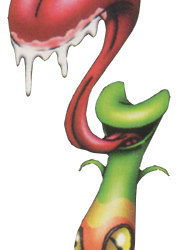
SLURPERON: it's one tiny pitcher plant with a giant tongue and then it has cool reptilian eyes at the bottom end. So simple and so rad! A fun way to stylize a pitcher plant monster without ripping off Victreebel.
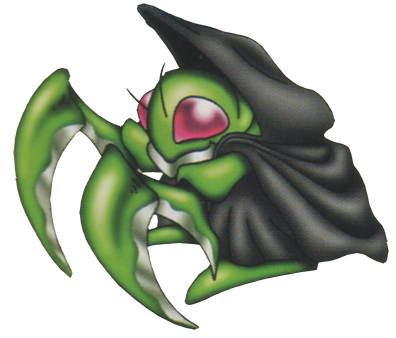
SICKLER: is a little tiny mantis in a robe, like the Tonberry from Final Fantasy but a mantis
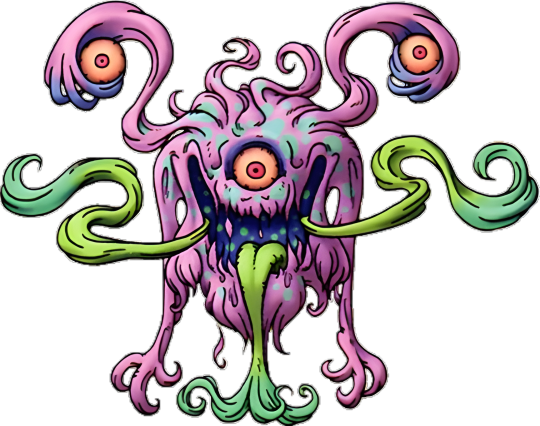
RAGIN' CONTAGION: a newer one, a gooey vaporous cyclops ghost that represents disease. In its first appearance as a boss in the series the English localizers decided it should talk like Yosemite Sam. Sure why not!
So I like the new game and it gave me some new favorites like Skellyfish and new appreciation for some others, but oddly it only has my very middle all-time faves
84 notes
·
View notes